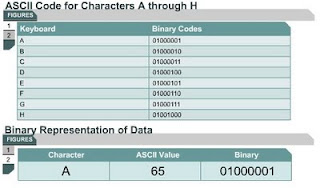Troubleshooting Internet connection problems
1.1.9 This page will show students how to troubleshoot hardware, software, and network configuration problems. The goal is to locate and repair the problems in a set amount of time to gain access to the curriculum. This lab will demonstrate how complex it is to configure Internet access. This includes the processes and procedures used to troubleshoot computer hardware, software, and network systems.
This page concludes this lesson. The next lesson will discuss computer number systems. The first page will describe the binary system.
Binary presentation of data
1.2.1 Computers work with and store data using electronic switches that are either ON or OFF. Computers can only understand and use data that is in this two-state or binary format. The 1s and 0s are used to represent the two possible states of an electronic component in a computer. 1 is represented by an ON state, and 0 is represented by an OFF state. They are referred to as binary digits or bits.
American Standard Code for Information Interchange (ASCII) is the code that is most commonly used to represent alpha-numeric data in a computer. ASCII uses binary digits to represent the symbols typed on the keyboard. When computers send ON or OFF states over a network, electrical, light, or radio waves are used to represent the 1s and 0s. Notice that each character is represented by a unique pattern of eight binary digits.
Because computers are designed to work with ON/OFF switches, binary digits and binary numbers are natural to them. Humans use the decimal number system, which is relatively simple when compared to the long series of 1s and 0s used by computers. So the computer binary numbers need to be converted to decimal numbers.
Sometimes binary numbers are converted to hexadecimal numbers. This reduces a long string of binary digits to a few hexadecimal characters. It is easier to remember and to work with hexadecimal numbers.
1.1.9 This page will show students how to troubleshoot hardware, software, and network configuration problems. The goal is to locate and repair the problems in a set amount of time to gain access to the curriculum. This lab will demonstrate how complex it is to configure Internet access. This includes the processes and procedures used to troubleshoot computer hardware, software, and network systems.
This page concludes this lesson. The next lesson will discuss computer number systems. The first page will describe the binary system.
Binary presentation of data
1.2.1 Computers work with and store data using electronic switches that are either ON or OFF. Computers can only understand and use data that is in this two-state or binary format. The 1s and 0s are used to represent the two possible states of an electronic component in a computer. 1 is represented by an ON state, and 0 is represented by an OFF state. They are referred to as binary digits or bits.
American Standard Code for Information Interchange (ASCII) is the code that is most commonly used to represent alpha-numeric data in a computer. ASCII uses binary digits to represent the symbols typed on the keyboard. When computers send ON or OFF states over a network, electrical, light, or radio waves are used to represent the 1s and 0s. Notice that each character is represented by a unique pattern of eight binary digits.
Because computers are designed to work with ON/OFF switches, binary digits and binary numbers are natural to them. Humans use the decimal number system, which is relatively simple when compared to the long series of 1s and 0s used by computers. So the computer binary numbers need to be converted to decimal numbers.
Sometimes binary numbers are converted to hexadecimal numbers. This reduces a long string of binary digits to a few hexadecimal characters. It is easier to remember and to work with hexadecimal numbers.


Comments
Post a Comment